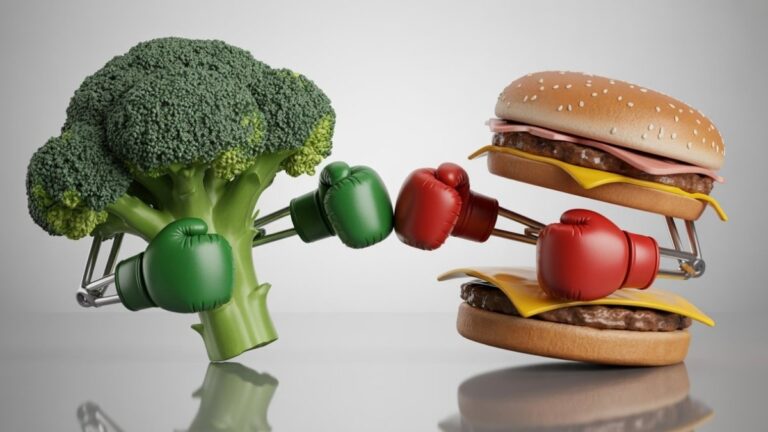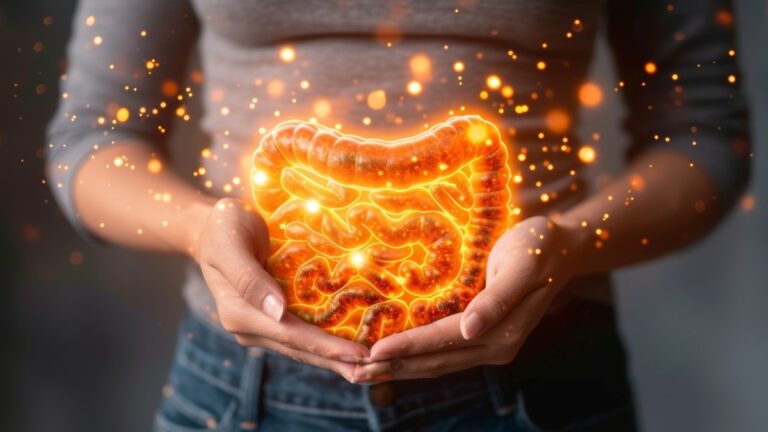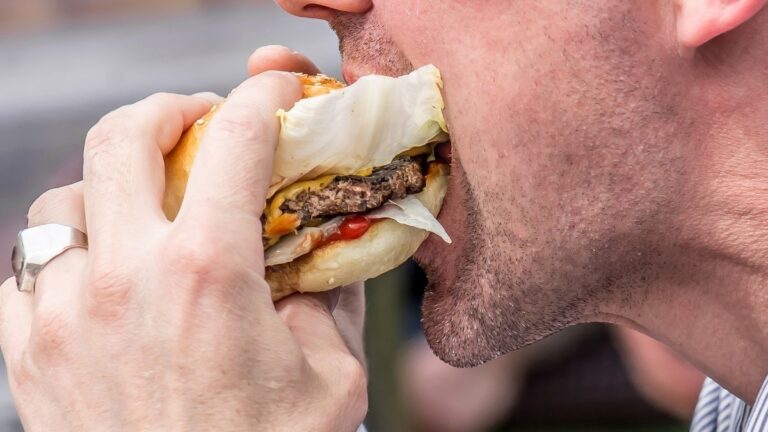15 “Innocent” Everyday Foods That Are Secretly Aging You Faster (Skip These Immediately If You Want To Age Like A Pro)
In 2025, scientific understanding of aging has evolved beyond chronology. The focus has shifted to biological age, the functional age of an individual’s cells, which is proving to be a more accurate predictor of healthspan and longevity than the number of years since birth.
Research increasingly confirms that biological age is not fixed; it is dynamically influenced by lifestyle factors, with nutrition chief among them.
While many individuals strive to make healthy choices, they may be unaware that specific, common foods can actively sabotage these efforts. The problem extends beyond simple caloric intake, touching on complex cellular mechanisms that can accelerate aging.
This report will provide a comprehensive, science-backed analysis of 15 foods that can accelerate aging.
1-Day “Age Like a Pro” Plan
Tap a box to see what’s cooking!
Oatmeal with Berries & Walnuts
Salmon Salad with Olive Oil Vinaigrette
Plain Greek Yogurt with Almonds
Poached Chicken, Quinoa & Broccoli
Sparkling Water with Lemon & Mint
The 3 Core Drivers: How Food Actually Ages You

Before examining specific foods, it is critical to understand the three interconnected mechanisms that form the foundation of diet-driven aging.
“Inflammaging”: This term refers to the chronic, low-grade, systemic inflammation that develops with age.
Unlike acute inflammation, which is a healthy and necessary response to injury, inflammaging is a persistent “smoldering” state that does not resolve.
This chronic inflammation is now identified by researchers as a primary driver of most age-related diseases, including heart disease, type 2 diabetes, and neurodegenerative conditions.
Oxidative Stress: This is a state of imbalance between unstable molecules, known as free radicals, and the antioxidants required to neutralize them.
Free radicals are natural byproducts of metabolism, but their levels can be dramatically increased by diet (e.g., fried foods) and lifestyle.
When free radicals overwhelm the body’s antioxidant defenses, they cause “oxidative stress,” which damages cell structures, proteins, and DNA, contributing to aging and disease.
Advanced Glycation End Products (AGEs): AGEs are harmful compounds that drive aging through two distinct pathways.
Endogenous (Internal) Formation: When blood sugar levels are high (often from consuming sugar or refined carbs), the excess sugar molecules non-enzymatically attach to proteins, like the collagen and elastin that keep skin firm.
This process, called glycation, creates AGEs. These AGEs make collagen stiff and brittle, leading to visible wrinkles and loss of elasticity.
Exogenous (Dietary) Formation: AGEs are also formed in foods, particularly those high in protein and fat, when they are cooked using high, dry heat methods like grilling, roasting, or frying.
These three mechanisms are not independent; they exist in a self-perpetuating cycle.
For instance, the formation of AGEs is known to promote both oxidative stress and inflammation, creating a unified process that accelerates biological aging. The following 15 foods are primary triggers for one or more of these mechanisms.
The Collagen-Damaging Culprits (Mainly AGEs & Sugar)
This group of foods accelerates aging primarily by spiking blood glucose, which in turn fuels the internal formation of Advanced Glycation End Products (AGEs). This glycation process directly damages structural proteins, leading to visible signs of aging.
1. Sugary Pastries & Doughnuts

Sugary pastries, doughnuts, and cookies represent a dual threat. First, they are laden with added sugars and refined flour, which cause a rapid spike in blood glucose, initiating the glycation process that damages collagen.
Second, these items are often commercial baked goods or deep-fried, meaning they are also high in dietary AGEs and trans fats formed during high-heat processing.
2. Sugary Drinks & Sodas
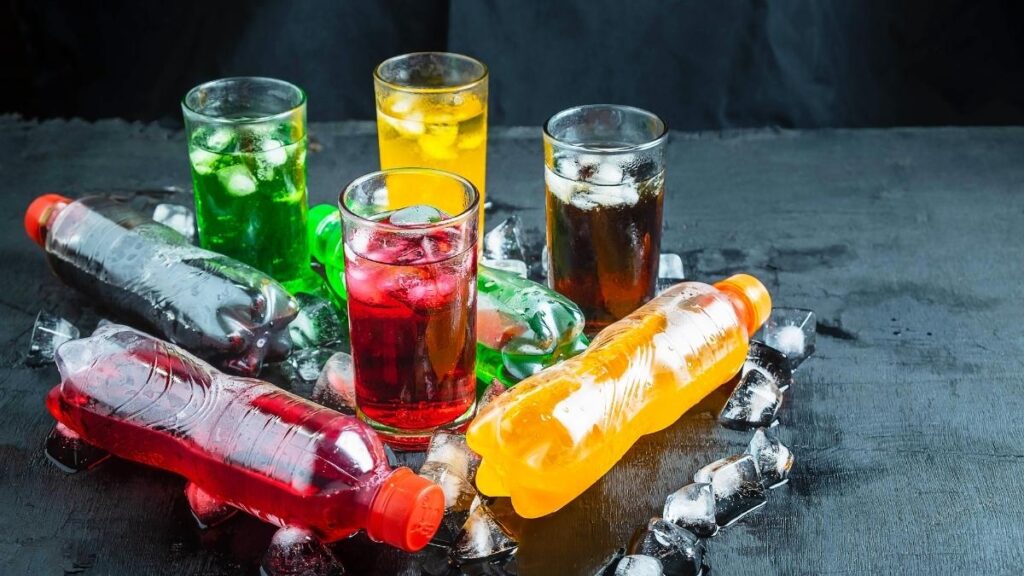
Sugar-sweetened beverages (SSBs), including sodas and fruit drinks, are identified by Harvard’s School of Public Health as the single largest source of added sugar in the U.S. diet.
A single 12-ounce can of soda can contain 7 to 10 teaspoons of sugar. This liquid sugar load is metabolized rapidly, overwhelming the system and providing a powerful substrate for AGE formation.
This link is no longer theoretical. A landmark 2024 study from UC San Francisco published in JAMA Network Open established a direct link between high added sugar intake and accelerated epigenetic aging.
The researchers discovered that even in individuals consuming otherwise “healthy” diets, each gram of added sugar consumed was associated with a measurable increase in biological age, as determined by epigenetic clocks.
3. Energy Drinks
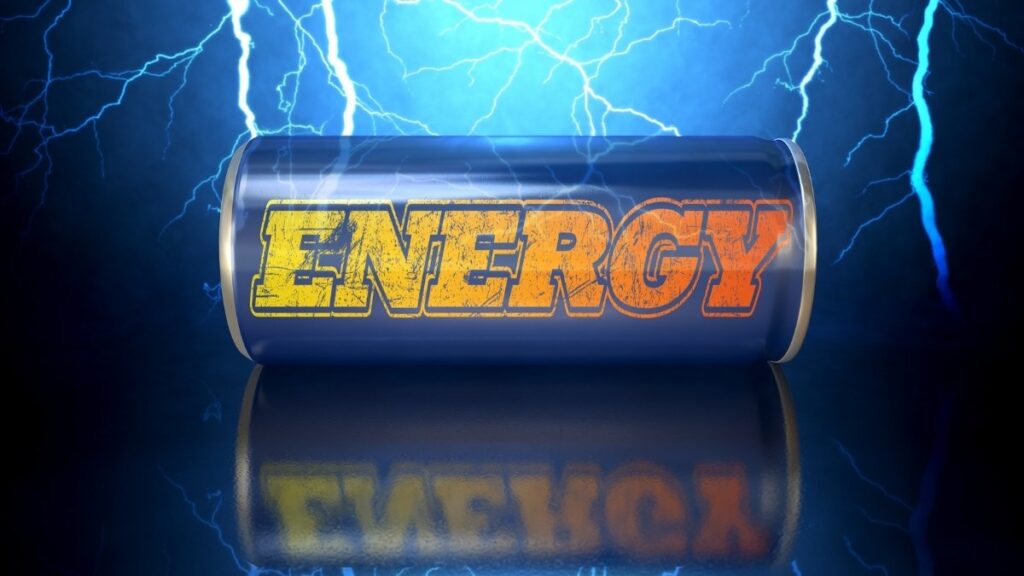
Energy drinks pose a similar, often more potent, threat than sodas. While many consumers focus on the stimulant content, these beverages are frequently high in sugar, with some containing even more than an equivalent-sized soft drink.
This high-sugar, high-caffeine combination delivers a significant glycation-promoting shock to the system, contributing to the “aging accelerator” effect of refined carbohydrates.
4. Flavored “Low-Fat” Yogurts
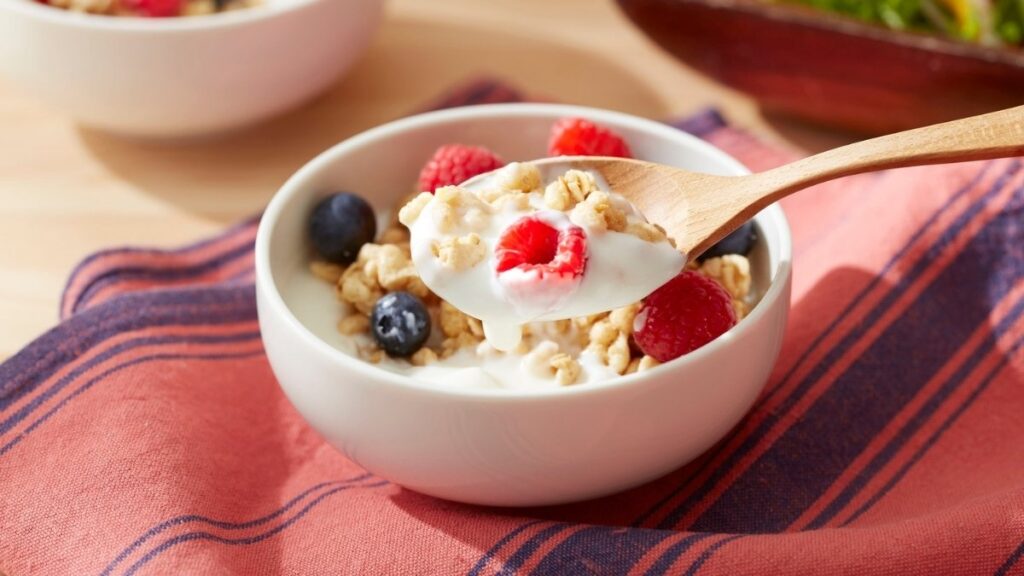
This food is a primary example of a “health halo” trap. Consumers associate yogurt with health, and “low-fat” with responsible dietary choices.
However, to compensate for the flavor lost when fat is removed, manufacturers often add large quantities of sugar.
A single, small serving of a “fruit-on-the-bottom” low-fat yogurt can contain 22 grams to over 45 grams of sugar, nearly a full day’s recommended limit. This hidden sugar contributes directly to the glycation and “inflammaging” processes, turning a perceived health food into a potent accelerator of aging.
The Inflammatory Accelerators (Nitrates, Sodium & AGEs)
This group of foods contributes to aging primarily by introducing pro-inflammatory compounds, excessive sodium, and high levels of pre-formed dietary AGEs, which create systemic inflammation and oxidative stress.
5. Processed Meats (Bacon, Hot Dogs, Deli Meat)

Processed meats, such as bacon, sausage, hot dogs, and deli meats, are preserved through methods like curing, salting, or smoking.
These processes introduce several problematic compounds. They are high in sodium and saturated fats, which are known drivers of inflammation.
More significantly, they contain preservatives like nitrates and nitrites. These compounds can lead to the formation of nitrosamines, which are associated with oxidative stress and DNA damage.
Recent 2024 research has directly linked the consumption of processed red meat to accelerated cognitive aging and to shorter telomere length, a key biomarker of cellular biological aging.
4-WEEK TRANSITION QUEST
Complete one level per week to win better health!
🛑 Enemies to Defeat (Phase Out):
Sugary sodas, energy drinks, artificial sweeteners (diet soda), and flavored “low-fat” yogurts.
🎯 Victory Strategy (Goal & Swaps):
Goal: Re-sensitize your palate. Swap sugary drinks for sparkling water or black coffee. Swap diet soda for kombucha. Use plain Greek yogurt + fresh fruit.
🛑 Enemies to Defeat (Phase Out):
Refined grains (white bread, pasta), sugary pastries, doughnuts, chips, and pretzels.
🎯 Victory Strategy (Goal & Swaps):
Goal: Stabilize blood sugar & reduce sodium. Swap white bread for sourdough/whole-grain. Swap pastries for dark chocolate. Swap chips for nuts or air-popped popcorn.
🛑 Enemies to Defeat (Phase Out):
Processed meats (bacon, hot dogs), char-grilled meats, and fatty cuts (like Ribeye).
🎯 Victory Strategy (Goal & Swaps):
Goal: Lower nitrates & AGEs. Swap sandwich meat for roast chicken or eggs. Change cooking method from grilling to poaching/steaming. Choose fish over fatty red meat.
🛑 Enemies to Defeat (Phase Out):
Ultra-processed microwave meals, trans fats (margarine, coffee creamer), and fried foods.
🎯 Victory Strategy (Goal & Swaps):
Goal: Remove industrial ingredients. Swap frozen dinners for simple 20-min homemade meals. Use avocado/olive oil instead of margarine. Use an air-fryer instead of deep-frying.
6. Char-Grilled Meats

This item highlights that the cooking method can be as impactful as the food itself.
While the sugar in pastries creates AGEs internally, high-heat, dry-heat cooking methods like grilling, broiling, and baking create massive levels of AGEs externally on the food, which are then absorbed upon ingestion.
The difference in cooking method is stark. One study measuring AGEs found that a 100g serving of broiled chicken contained 5,828 kU (kilo-units) of AGEs, whereas the same portion of boiled chicken contained only 1,124 kU.
This demonstrates that the char and browning (the Maillard reaction) sought in grilling are, in effect, the physical creation of aging compounds.
7. Fries & Fried Foods
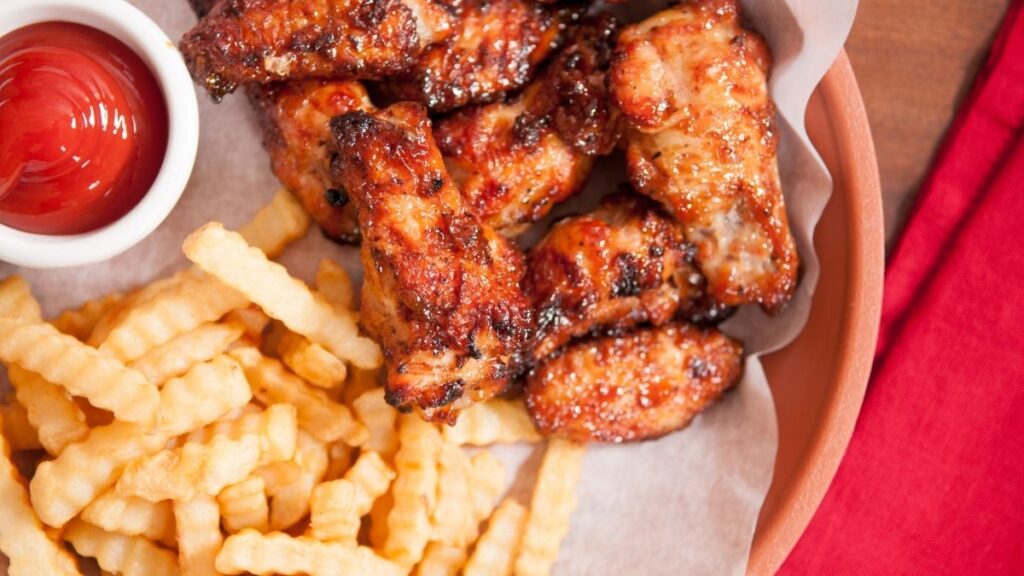
Deep-fried foods, especially starchy items like French fries, accelerate aging through two distinct pathways.
Oxidative Stress: The process of deep-frying at high temperatures creates free radicals in the cooking oil, which are then transferred to the food. Ingesting these free radicals can overwhelm the body’s antioxidant systems, leading to cellular damage.
Acrylamide Formation: Acrylamide is a chemical that forms in starchy foods (like potatoes) during high-temperature cooking methods such as frying and baking.
A 2024 study linked frequent consumption of fried foods, particularly fried potatoes, to a 12% higher risk of anxiety and a 7% higher risk of depression, with researchers suggesting the mechanism is acrylamide-induced neuroinflammation.
8. Salty Snacks (Chips, Pretzels)

The primary aging agent in these snacks is excess sodium. While sodium is an essential electrolyte, the high levels found in processed snacks can be detrimental.
Recent 2024 studies have demonstrated that high-salt diets can accelerate skin aging in as little as eight weeks.
The mechanism is twofold: high salt intake increases oxidative stress in skin cells and has been shown to impair the production of collagen, the skin’s primary structural protein.
The “Hidden” Traps (UPFs, Trans Fats & Omega-6)
This group includes foods that are particularly deceptive. They may be controversial, marketed as “neutral,” or hidden within seemingly complex products, yet they contribute significantly to the systemic processes of aging.
9. Refined Grains (White Bread, Pasta)
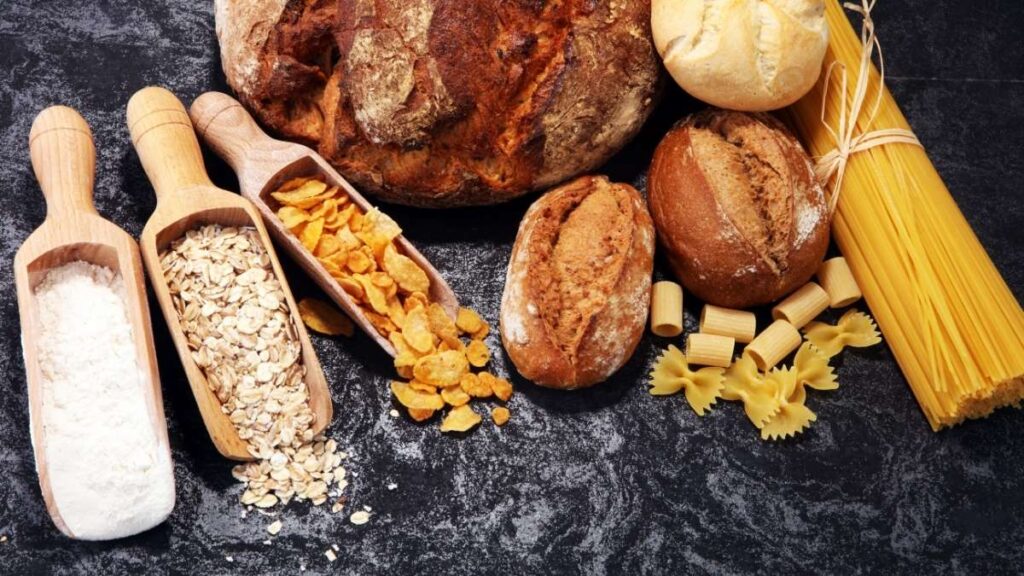
Refined grains, such as those in white bread, white pasta, and commercial baked goods, have been “stripped of nutrients and fiber”. From a metabolic standpoint, the body treats them almost identically to sugar.
They possess a high glycemic index, causing the same rapid spike in blood sugar that accelerates the internal formation of collagen-damaging AGEs.
10. Ultra-Processed Meals (Microwave Dinners)
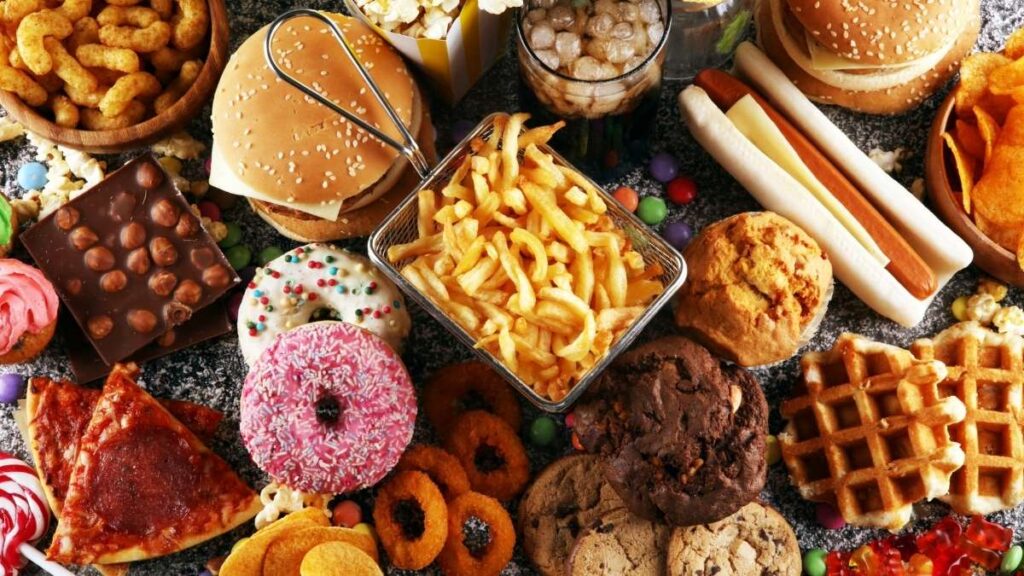
Ultra-processed foods (UPFs), such as microwave dinners, instant noodles, and frozen pizzas, are a critical topic for 2025. These are “industrial formulations” that account for nearly 60% of daily calories in the U.S.
The aging effect of UPFs is not just due to their poor nutritional profile (high in sugar, salt, and unhealthy fats). 2024 research published in the American Journal of Clinical Nutrition found that a diet high in UPFs is directly associated with accelerated biological aging, as measured by epigenetic clocks.
One study found that for every 10% increase in a person’s UPF intake, their biological age was 0.21 years older.
Experts suggest this link may be due to the “cocktail” of industrial additives, emulsifiers, and even endocrine-disrupting chemicals like bisphenols and phthalates that can migrate from the packaging into the food.
11. Trans Fats (Margarine, Coffee Creamer)
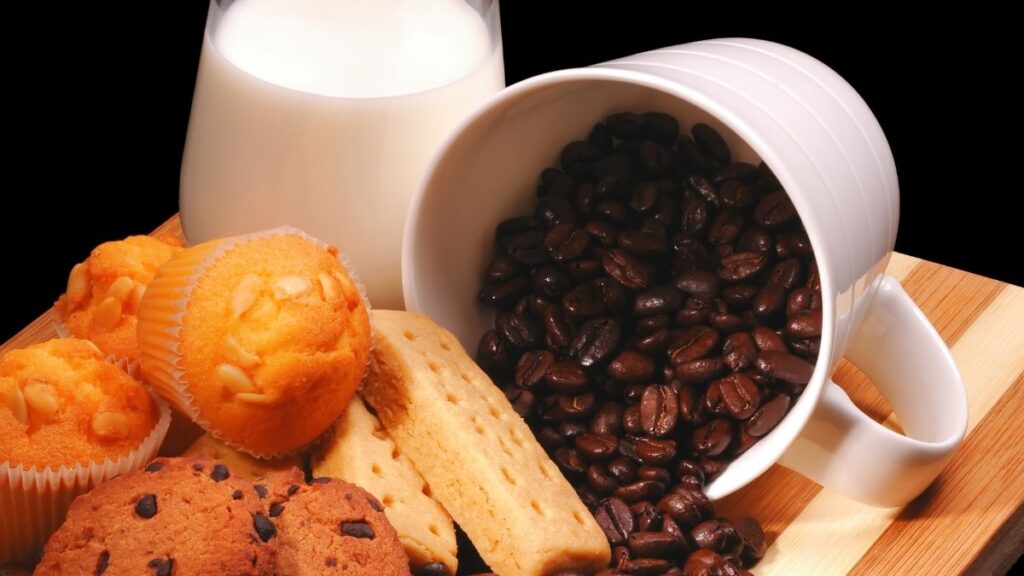
Artificial trans fats (partially hydrogenated oils) are widely considered the “worst type of fat to eat”. While the FDA banned their addition to foods in the U.S. as of 2020 , they still exist in the food supply of many countries and can linger in products with long shelf lives.
Trans fats are potent drivers of inflammation, and they negatively impact cholesterol by raising “bad” LDL and lowering “good” HDL. They are most commonly found in stick margarine, non-dairy coffee creamers, refrigerated dough, and microwave popcorn.
12. Refined Vegetable/Seed Oils (Soybean, Corn)

This category is a source of significant public confusion. Social media narratives often label refined seed oils (e.g., soy, corn, canola) as “toxic” and pro-inflammatory due to their high omega-6 fatty acid content.
However, 2025-era expert analysis from leading institutions clarifies this “debate.” Experts from Stanford University and the Cleveland Clinic state this is largely a misunderstanding.
Christopher Gardner, PhD, of Stanford, notes that omega-6 fatty acids are essential and that replacing saturated fats (like butter and lard) with unsaturated fats (like seed oils) is beneficial for cardiovascular health.
The real problem, as Cleveland Clinic dietitian Julia Zumpano notes, is not the oil itself, but the ultra-processed foods they are commonly found in.
The industrial processing of these oils for UPFs is the issue, not the oil used for home cooking. The key takeaway is to avoid the UPFs that contain these oils, rather than the oils themselves.
The Final Few: Gut-Disruptors & Dehydrators
This final category of foods accelerates aging by disrupting the sensitive gut microbiome—a key regulator of inflammation—and by depleting the body of the very nutrients it needs for cellular repair.
13. Artificial Sweeteners (in Diet Soda)
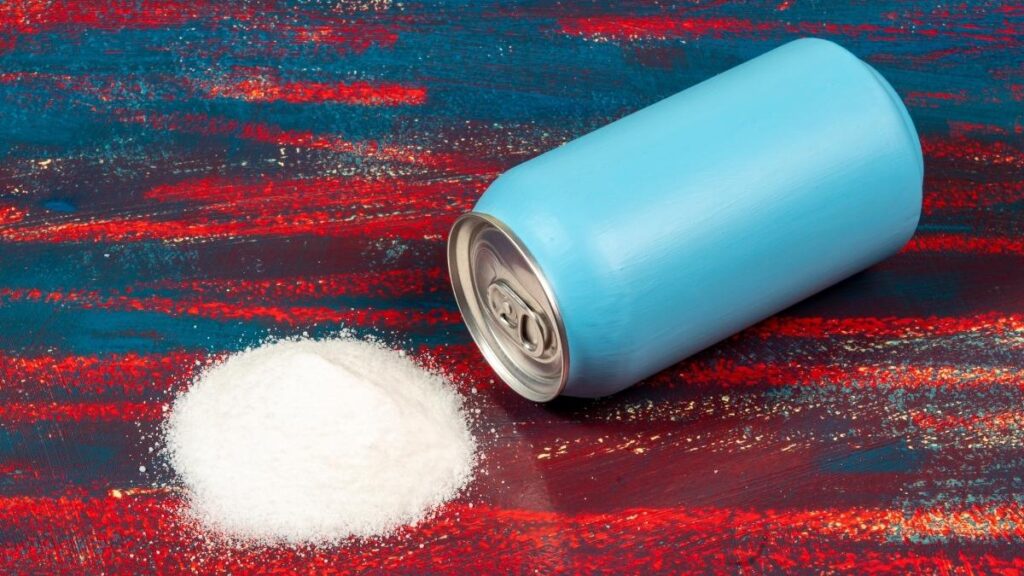
For decades, diet sodas and artificial sweeteners were considered a “healthy swap” for sugar. However, a wave of 2024 and 2025 research now demonstrates these compounds are not benign.
A 2024 study from Cedars-Sinai investigators found that artificial sweeteners (including aspartame and sucralose) “significantly alter” the microbiome of the gut, particularly the small intestine.
This disruption of the gut microbiome, or “dysbiosis,” is shown in animal studies to disrupt gut integrity and elevate systemic inflammatory markers like IL-6 and TNF-alpha. In essence, by disrupting the gut, these sweeteners can directly trigger the systemic, low-grade inflammation that defines “inflammaging.”
14. Excessive Alcohol

Alcohol accelerates aging via a two-pronged attack: it actively causes damage while simultaneously preventing repair.
Causes Damage: Alcohol is a diuretic that dehydrates the body, which can make fine lines and wrinkles on the skin appear more pronounced. It also acts as a toxin that promotes systemic inflammation and oxidative stress.
Prevents Repair: This is the more insidious effect. Chronic alcohol consumption depletes the body of essential nutrients required for skin health and collagen synthesis, specifically Vitamin A, Vitamin C, and Zinc.
Without adequate levels of these “repair” tools, the body’s ability to produce new collagen and fight oxidative stress is severely compromised.
15. Fatty Meats (e.g., Ribeye, Pork Shoulder)
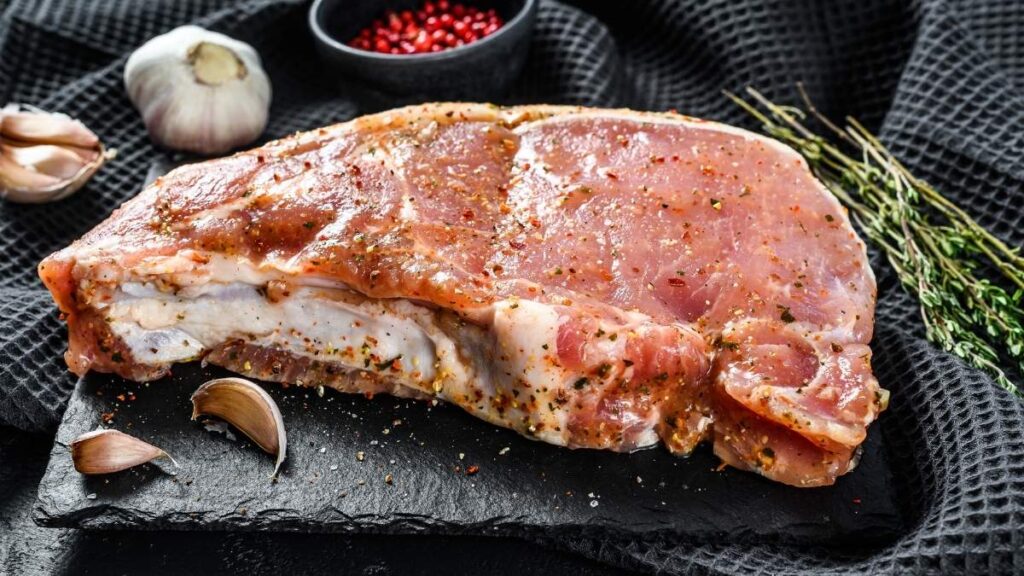
Distinct from processed meats, fatty cuts of unprocessed meat like ribeye steak or pork shoulder are on this list for a simpler reason: their high content of saturated fat. A high intake of saturated fat, as found in both fatty red meats and full-fat dairy, is linked to inflammation.
While not as acutely problematic as processed meats, these fats are best replaced with lean protein sources that provide the amino acids necessary for skin and tissue integrity without the inflammatory load.
Your 2025 Action Plan: The “Pro-Aging” Swap Sheet
This analysis is not intended to promote deprivation, but rather to inform smart substitution.
The “Pro-Aging” Swap Shop
Tap a red tag to make a healthy swap!
The goal is to systematically lower the body’s total burden of inflammation, oxidative stress, and AGEs. The following table provides actionable, science-backed swaps for the 15 foods discussed.
Conclusion
The scientific evidence available in 2025 compellingly demonstrates that dietary choices are a primary modulator of biological age. Aging is no longer viewed as a passive, chronological process but as an active, biological one that can be influenced.
The analysis confirms that aging is accelerated not by a single “bad” food, but by a “cocktail” of biochemical stressors.
The 15 foods detailed in this report are the most significant delivery mechanisms for these stressors: sugar and refined carbs drive internal AGE formation and collagen damage; high-heat cooking and processed meats introduce inflammatory nitrates and external AGEs.
Industrial compounds in UPFs and artificial sweeteners appear to accelerate aging at a cellular, epigenetic level by disrupting the gut and fueling inflammaging.
Recommended Infographics
The Two-Front War on AGEs: A simple graphic showing two pathways leading to “Wrinkles & Stiff Joints.”
Pathway 1 (Internal): Sugary Pastry -> High Blood Sugar -> Sugar + Collagen -> AGEs.
Pathway 2 (External): Grilled Steak -> High-Heat Cooking -> Ingested AGEs.
Takeaway: “Two different foods, one aging mechanism.”
Biological Age vs. Chronological Age: A visual showing two 45-year-old individuals.
Person A (Chronological Age: 45 | Biological Age: 52): Shows a plate with UPFs, soda, processed meat. Has a “PhenoAge Gap” of +7 years.
Person B (Chronological Age: 45 | Biological Age: 40): Shows a plate with salmon, vegetables, and berries.
Headline: “Your Diet Can Make Your Cells Older (or Younger). A 2024 study found a 10% rise in UPFs added 0.21 years to biological age.”
The “Age-Like-a-Pro” Swap Sheet: A visually clean, mobile-friendly version of the table in the final section. Highly shareable and practical.



